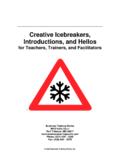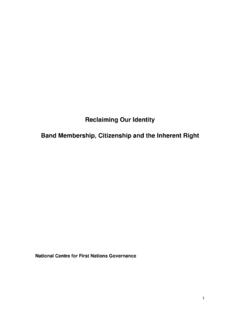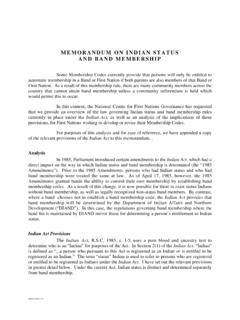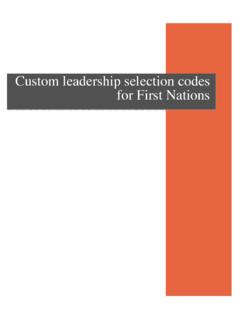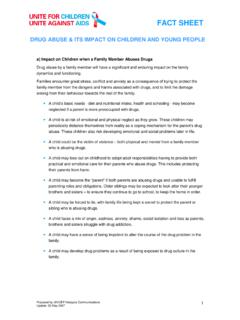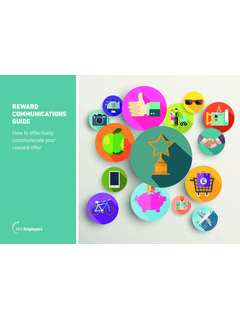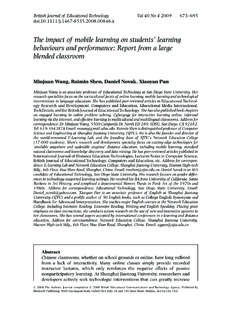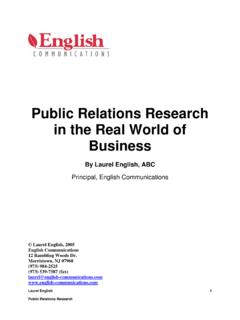Transcription of Elements of a Strategic Communications Plan
1 Elements of a Strategic Communications plan Determine Goal Identify and Profile Audience Develop Messages Select communication Channels Choose Activities and Materials Establish Partnerships Implement the plan Evaluate and Make Mid-Course Corrections Step 1: Determine Goal To initiate a successful and effective Communications effort, start with an assessment of your current organizational goals. Examine what your organization stands for its mission, values and beliefs. Look closely at who your organization is serving. This process will help narrow and sharpen the focus for your communication initiative(s). What issue is most important to your organization right now? _____ _____ _____ _____ Who is most affected by the issue stated above?
2 _____ _____ _____ _____ Who makes decisions about the issue? _____ _____ _____ _____ What is the overall goal you want to achieve? ( , What change would you be able to observe?) (Be specific.) _____ _____ _____ _____ What tangible outcomes would you like to achieve through a Communications effort? , How will you know you are achieving your goals? (Be specific. What would you see, hear, or have in-hand that would let you know you are making progress toward the goal?) _____ _____ _____ Step 2: Identify and Profile the Audiences Once you ve identified your key issues, it s time to identify and profile specific audiences to target with a Communications initiative.
3 The reason for taking the time to look this closely at your audiences is that this kind of background information is essential in choosing the most effective ways to communicate with the audience. Madison Avenue has learned this lesson well, now we need to apply some of the same kind of thinking to communicating about your issue. Audience Definition Worksheet Of the audiences listed on the Step 1 worksheet, whose knowledge, attitudes and behavior must be changed in order to meet your goal? (These groups now become your primary audiences.) _____ _____ _____ _____ Who else is affected if you succeed in your goal? (secondary audience) _____ _____ _____ _____ Are there others who can influence primary and secondary audiences?
4 (tertiary audiences) (You may wish to design a communication initiative to reach some of these audiences as well. Or you may see a role for these folks as allies and partners .) _____ _____ _____ _____ Now you are ready to complete worksheets for each of your audiences identified above. (see next page) Audience Segmentation Worksheet (Note: you will probably need to make multiple copies of this worksheet.) Audience: _____ Describe what you know about this audience s knowledge, attitudes and behaviors as they relate to your issue: _____ _____ _____ _____ _____ _____ What are the barriers to this audience fully supporting or participating in reaching your goal?
5 What are the benefits if they do? _____ _____ _____ _____ What are the characteristics of this audience? How do they spend their time? What is their gender, ethnicity and income level? How have they been educated? What are the language considerations? What or who are they influenced by? What makes new information credible for them? What or who could motivate change or action? _____ _____ _____ _____ _____ _____ _____ _____ _____ _____ _____ _____ Step 3: Develop Messages Your messages are closely tied to your goal and objectives. They deliver important information about the issue and compel the targeted audience to think, feel, or act.
6 They can: Show the importance, urgency, or magnitude of the issue Show the relevance of the issue Put a face on the issue Be tied to specific audience values, beliefs, or interests of the audience Reflect an understanding of what would motivate the audience to think, feel, or act Be culturally relevant and sensitive Be Memorable The messages you develop by using the worksheet provided in this section can be used in many ways. First, they are a set of statements that you and your team agree upon as conveying the key information for your initiative. They will not include all the detail and supporting ideas and data that you may use in printed materials or other forms of communication .
7 The messages you develop in the worksheets can become the underlying themes for your materials and activities. You may develop slogans based on them. You may develop sets of talking points that members of your team will use in making presentations. And they easily become the basis for radio and print PSAs, the genesis for posters, and may suggest topics for fact sheets, drop-in articles, and even letters to the editor or newspaper editorials. Before turning to the Message Development Worksheet, take a few moments to read Considerations for Message Construction. Considerations for Message Construction Both the channel (the conduit for sending your message to the chosen target audience) and the purpose of communicating environmental information influence message design.
8 Information may be designed to convey new facts, alter attitudes, change behavior, or encourage participation in decision-making. Some of these purposes overlap; often they are progressive. That is, for persuasion to work, the public must first receive information, then understand it, believe it, agree with it, and then act upon it. Regardless of the purpose, messages must be developed with consideration of the desired outcome. Factors that help determine public acceptance include: Clarity Messages must clearly convey information to assure the public s understanding and to limit the changes for misunderstanding or inappropriate action. Clear messages contain as few technical/scientific/bureaucratic terms as possible, and eliminate information that the audience does not need in order to make necessary decisions (such as unnecessarily detailed explanations).
9 Readability tests can help determine the reading level required to understand drafted material and help writers to be conscientious about the selection of words and phrases. Consistency In an ideal world there would be specific consensus on the meaning of new findings, and all messages on a particular topic would be consistent. Unfortunately, consistency is sometimes elusive. Experts tend to interpret new data differently, making consensus among government, industry, and public interest groups difficult. Main points The main points should be stressed, repeated, and never hidden within less strategically important information. Tone and appeal A message should be reassuring, alarming, challenging, or straightforward, depending upon the desired impact and the target audience.
10 Messages should also be truthful, honest and as complete as possible. Credibility The spokesperson and source of the information should be believable and trustworthy. Public need For a message to break through the information clutter of society, messages should be based on what the target audience perceives as most important to them, what they want to know, and not what is most important or most interesting to the originating agency. Prior to final production, messages should be pretested with the target audiences (and in some cases with channel gatekeepers ) to assure public understanding and other intended responses. Source: Making Health communication Programs Work: A Planner s Guide, Office of Cancer Communications , National Cancer Institute, National Institutes of Health (1992).


